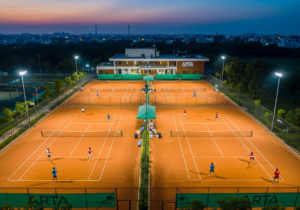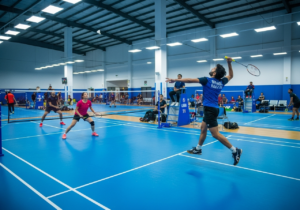Pickleball Strategy for Beginners: Win More Matches with Smart Play

Pickleball is easy to pick up but much harder to master. If you’re a beginner, learning the right pickleball strategy early can save you months of frustration and give you a serious edge on the court. Even without super-fast reflexes or power shots, smart play can help you win more matches.
So let us walk you through the best pickleball strategies for beginners in the upcoming discussion. Let us explain why certain tactics work and give practical tips to start using them immediately.
Why Strategy Matters More Than Power in Pickleball
Many new players think that power wins games. In reality, placement, patience, and positioning matter more. Pickleball court dimensions are smaller than those of a tennis court. So, there’s less room for big winners. Instead, it’s about setting up the point smartly, forcing errors, and controlling the pace.
In fact, most advanced pickleball strategy techniques emphasise slowing the game down. They focus on hitting safer shots and playing smart at the net. If you think it is just muscle play, you’re wrong again! You need smartness too. Mastering the mindset early will put you ahead of many recreational players who still rely purely on force.
The Best Pickleball Strategy and Rules
When you want to master pickleball, experience teaches many more tactics at a personal level. But, irrespective of a player’s experience, some common techniques are necessary to internalise to learn the game faster. They’re often formulated by expert players. \
1. Master the Serve and Return with Purpose
The serve and return set the tone for the entire rally.
Serving strategy:
- Serve deep toward your opponent’s backhand.
- Aim for consistency over speed serves must land inbounds to be effective.
- Occasionally mix it up with different placements to keep your opponent guessing.
Return strategy:
- Always return deep and preferably toward the middle or backhand side.
- A deep return buys you time to move forward toward the kitchen line, which is where most points are won.
- Avoid fancy shots on the return.
Getting these two shots right forms the foundation of a good pickleball game strategy.
2. Get to the Kitchen Line Quickly and Stay There
One of the most basic but critical pickleball strategies for beginners is “move up” after your return or serve. The kitchen (non-volley zone) is where most points are decided. At the kitchen line, you can volley shots before they bounce and pressure your opponents with quicker reactions.
How to do it smartly:
- After serving, move up carefully behind your third shot (more on that below).
- After returning, move up immediately and prepare for a quick volley exchange.
- Stay low, balanced, and ready at the line.
Players who dominate the kitchen line usually control the match. Make it your early goal in every rally.
3. Learn the Third Shot Drop
After you serve, your opponents will likely hit a deep return. Now comes your third shot.
This is where many beginners make mistakes by trying to drive the ball hard. Instead, you need a soft, controlled shot the third shot drop.
The third shot drop:
- A soft shot that arcs over the net and lands in the opponent’s kitchen.
- It forces your opponents to hit upward, giving you time to advance to the net.
- Even if it’s not perfect, a soft ball is harder to attack than a hard one.
4. Keep the Ball Low Over the Net
High balls are attackable balls. In pickleball, lifting the ball gives your opponent the green light to smash it down on you. A smart beginner focuses on keeping shots low, forcing opponents into less aggressive plays.
Tips for keeping balls low:
- Use controlled swings rather than big windups.
- Focus on the feel and angle of your paddle face.
- Aim to clear the net by just a few inches when dinking or dropping.
Keeping the ball low neutralises big hitters. Now you can dictate the pace.
5. Dink with Purpose, Not Just to Rally
You might find yourself dinking exchanging soft shots back and forth across the kitchen.
But dinking isn’t about “waiting.” It’s an active part of your pickleball game strategy.
Smart dinking:
- Move your opponent out wide or pull them forward and backwards.
- Look for high balls or mistakes to attack.
- Stay patient but alert be ready to pounce when the opportunity arises.
Mix your dink locations: cross-court, straight ahead and occasionally a surprise down the line. Keeping your opponent uncomfortable.
6. Communicate and Work as a Team in Doubles
Pickleball doubles requires teamwork. If you and your partner aren’t communicating, you’ll lose points even with good shots.
Best practices:
- Call “mine” or “yours” clearly on the balls in the middle.
- Move as a unit both players should be roughly at the same depth.
- Cover lobs together: one goes back while the other covers the middle.
7. Understand When to Attack
Beginners often attack too early. Advanced pickleball strategy teaches that you should only attack when you have a clear advantage.
If you try to smash a low ball, you’ll often hit it into the net or out of bounds.
Smart attacking tips:
- Attack only high balls above net level.
- Focus on placement, not brute force aim at feet or sidelines.
- After an attack, be ready for a fast counterattack.
8. Anticipate, Don’t React
One of the biggest differences between new and experienced players is anticipation. Smart players start preparing early.
How to improve anticipation:
- Watch your opponent’s body language and paddle face.
- Expect cross-court shots during dinks.
- Prepare for a smash if your opponent steps into a high ball.
9. Keep Moving and Reset When Needed
You’ll face fast rallies, awkward balls, and moments of chaos. Instead of trying to do too much, a good beginner understands when to reset the point hitting a soft ball into the kitchen to slow things down.
Resetting strategies:
- Use a soft block volley to land the ball in the kitchen.
- Regain kitchen line position before trying another attack.
- Don’t panic; slowing the game is a winning move.
10. Learn the Basic Pickleball Rules and Strategy
You can’t apply smart tactics without knowing the rules inside and out. Understand faults, lets, kitchen violations, serve rules, and scoring formats. Knowing pickleball rules and strategy helps you play smarter. You can avoid mistakes. And argue your case if needed.
Quick pickleball rules refresher:
- Only the serving team can score.
- Serves must be underhand and land diagonally.
- No volleying while standing in the kitchen.
- Games typically play to 11 points (win by 2).
Final Thoughts
Winning at pickleball is about smart positioning, controlled shots, and better decision-making. Focus on improving your serve. Practice getting to the kitchen line, mastering your third-shot drop, and keeping balls low.
By building strong habits early, you set yourself up for long-term success. Keep practising and stay patient. You’ll notice a big jump in your match results within a short time.If you’re curious about how pickleball stacks up against similar sports, explore the difference between padel and pickleball for a broader view.
FAQs
Why is getting to the kitchen line important in pickleball?
Controlling the kitchen line allows you to volley quickly and limit your opponent’s shot options. Most points are won near the net. So, positioning there gives a tactical advantage throughout the rally.
What is the purpose of the third shot drop in pickleball?
The third shot drop lets you move forward by sending a soft shot into the kitchen. Opponents will find it hard to attack. It creates time to reach the net safely.
How do I know when to attack during a rally?
Attack only when the ball is above the net level. Focus on placing shots near the feet or into open spaces instead of swinging hard without a clear setup.
What does it mean to reset the point in pickleball?
Resetting means hitting a soft shot into the kitchen to stop a fast exchange. It slows down the rally, reduces pressure, and lets you recover positioning before attempting another aggressive shot.




